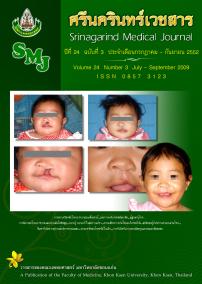ThaiScience
ThaiScience
SRINAGARIND MEDICAL JOURNAL
Volume 35, No. 05, Month SEPTEMBER, Year 2020, Pages 515 - 522
Incidence and predictors of residual disease in women with high-grade squamous intraepithelial lesion (hsil) and positive margins after cervical loop electrosurgical excision
Chalita Kingnate
Abstract Download PDF
Background and Objective: Women who have high-grade squamous intraepithelial lesion (HSIL) and positive margins after an initial cervical loop electrosurgical excision procedure (LEEP) carry a risk of invasive cervical carcinoma if left untreated. This study aimed to find factors predicting residual disease in women with histologic HSIL and positive margins after LEEP. Methods: This retrospective cohort study was undertaken among women with histologic HSIL who had positive surgical margins following LEEP at Lamphun Hospital between January 2014 and March 2020. Factors predicting residual lesion were assessed by univariate and multivariate logistic regression analysis. Results: One hundred and thirteen women were included, residual disease was found in 56 women (49.5%). Multivariate analysis showed that only age ≥35 years (AOR = 10.8; 95%CI 1.1-109.8, p = 0.045) and a large lesion on LEEP specimen (3-4 quadrants) (AOR = 9.5; 95%CI 3.4-26.2, p <0.001) were significantly independent factors associated with residual disease. Conclusions: Age ≥35 years and large lesion are the significant independent predictors for residual disease in women who had HSIL with positive margins after LEEP.
Keywords
HSIL LEEP positive margil predictor residual diseaseSRINAGARIND MEDICAL JOURNAL
Published by : Faculty of Medicine, Khon Kaen University
Contributions welcome at : http://www.smj.ejnal.com/e-journal/journal/index.php
